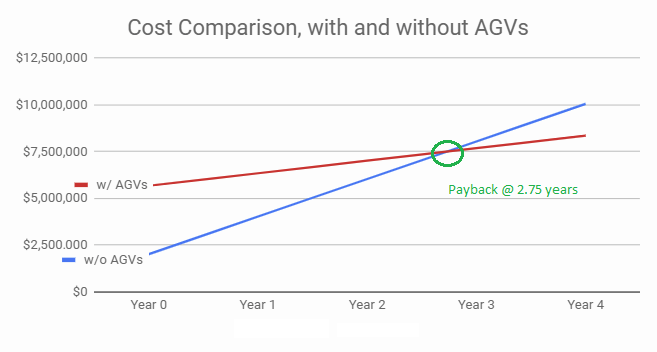Case Study
Rising warehouse labor costs are driving more and more companies to invest in Automatically Guided Vehicles (AGVs). The return on an AGV investment is a function of how many AGVs you purchase, so it is critical to determine exactly how many you will need; right-sizing your fleet could save your company millions. Traditional analyses carried out on spreadsheets using averages (of demand and labor availability) are insufficient for such a complex system. Simulation, on the other hand, is a much more appropriate tool to validate a design decision, as it can accurately account for the complexity and seasonality of the underlying system.
The cost of warehouse employees has increased 30% since 2013, and 6.7% since 2018. The is attributable to growth in e-commerce and the arrival of Amazon who can afford to pay warehouse employees as much as $15 per hour. Less loyalty means greater turnover: in a study of over 15K warehouse workers conducted by Prologistix, pay was the #2 reason employees switched employers, and 69% of employees that switched employers did so for an increase of $2 per hour or less! Since warehouse demand is highly seasonal, companies may end up losing their best employees right when they need them most, e.g. the holidays, and with them goes a wealth of knowledge and dependability.
AGVs, on the other hand, are deterministic. They work at a known rate every day and are dependable. Developing a design basis for the type and number of vehicles can be complex, but it’s only necessary once.
Capital Authorization comes down to 2 things: cost and savings. Confidence in both makes everyone’s job easier. Consider the following example:
No AGVs: 30 employees @ $67,000 = $2.01M/yr
With AGVs: 10 employees and 20 AGVs = $670k/yr + $30k/yr maintenance + $5M investment

Typical Consumer Product manufactures target an 18-month to 3-year payback period. All else equal, rising operations cost shifts the payback sooner which makes an investment in AGVs more attractive.
It’s not common practice to test the integrated systems before they’re installed. It’s a new technology called emulation which is analogous to digital twins. Essentially, the computer systems which act as traffic cops for AGVs are connected directly to the simulated system. This allows the OEM and site team to test and fix the systems before start-up — typically saving 50% of start up costs.
The savings from right-sizing depends on the size and application, and it typically comes from the cost of AGVs. Simulating and emulating can save $500k to $3M in optimizing the investment.
You’ll know once you track utilization reports in the field. Typically conservative assumptions may be the root cause. Other unexplored formats could have provided the same service level at a reduced cost.
Going back for more $$ is rarely a pleasant process. And it may impact your organizations commitment to automation over the next several years. You’ll know once order levels aren’t met on time and labor resources are greater than expected once the system is installed.
Drop me a line at ari@autointel.io.




